 Cow grazing in the pasture. | |
| Country of origin | France |
|---|---|
| Distribution | Vosges |
| Use | mixed |
| Skin colour | spotted black or red |
| |
The Vosgienne is a French cattle breed of medium size well adapted to mountainous regions, primarily found in the Vosges Mountains.
 Cow grazing in the pasture. | |
| Country of origin | France |
|---|---|
| Distribution | Vosges |
| Use | mixed |
| Skin colour | spotted black or red |
| |
The Vosgienne is a French cattle breed of medium size well adapted to mountainous regions, primarily found in the Vosges Mountains.
According to Alain Raveneau, it originates from cows that arrived in the massif in the 17th century. It is said to have been imported by Swedish soldiers who devastated the Duchy of Lorraine during the Thirty Years' War and crossbred with the local population. [1] It is believed to have found a terrain in the Vosges similar to Scandinavia and naturally adapted to the granite massif and mountainous climate. [2] Philippe J. Dubois , however, considers this origin more of a legend. According to him, the breed comes from a Jura population, close to the Tourache of Franche-Comté, an ancestor of the Montbéliarde. This ancient population would have been crossbred with Brown and Prim'Holstein breeds. Photos from the late 19th century to the 1960s show animals that were almost entirely black with white heads or piebald, but very few were speckled. [3]
In the past, two types coexisted, selected from different geographical areas: in the Bruche valley, cows were small and slender, and in the Munster region, they were more massive. The first type disappeared before 1980. From 1971, an introduction of Telemark bull semen took place in 12% of the population. [3]
It is a dual-purpose breed, with both productions being valued equally without favoring one over the other. [4] Before the advent of mechanized traction, the Vosgienne breed was also used as a draught animal. Its well-balanced milk, rich in useful substances, is highly valued for AOC Munster cheese. [5] While heifers may lack a bit of precocity, this drawback is offset by very good longevity. [4]
The Vosgienne breed, represented by the cow Candy, is the official mascot of the 2011 International Agricultural Show in Paris. [6] [7]
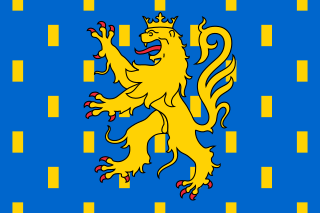
Franche-Comté is a cultural and historical region of eastern France. It is composed of the modern departments of Doubs, Jura, Haute-Saône and the Territoire de Belfort. In 2021, its population was 1,179,601.

Haute-Saône is a department in the Bourgogne-Franche-Comté region of northeastern France. Named after the river Saône, it had a population of 235,313 in 2019. Its prefecture is Vesoul; its sole subprefecture is Lure.
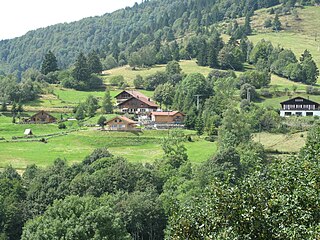
The Vosges are a range of medium mountains in Eastern France, near its border with Germany. Together with the Palatine Forest to the north on the German side of the border, they form a single geomorphological unit and low mountain range of around 8,000 km2 (3,100 sq mi) in area. It runs in a north-northeast direction from the Burgundian Gate to the Börrstadt Basin, and forms the western boundary of the Upper Rhine Plain.

Munster, Munster-géromé, or (Alsatian) Minschterkaas, is a soft cheese with a strong taste and aroma, made mainly from milk first produced in the Vosges, between the Alsace-Lorraine and Franche-Comté regions in France. The name "Munster" is derived from the Alsace town of Munster, where, among Vosgian abbeys and monasteries, the cheese was conserved and matured in monks' cellars.

The Aubrac or Laguiole is a French breed of beef cattle. It originates on the Plateau de l'Aubrac in the Massif Central in central southern France, from which it also takes its name. It has a wheat-coloured coat and dark hooves, switch, muzzle and eyes.

The Aure et Saint-Girons or Casta is an endangered French breed of domestic cattle. The breed name derives from its two principal areas of origin, the Vallée d'Aure in the département of the Hautes-Pyrénées, and the area of Saint-Girons and the Couserans in the Ariège. The name "Casta" derives from its chestnut colour.

The Lourdaise is an endangered French breed of domestic cattle. It is named for the town of Lourdes, in the Hautes-Pyrénées département of the region of Occitanie, and originated in the surrounding country, particularly in the cantons of Argelès, Bagnères-de-Bigorre and Ossun. It was formerly a triple-purpose breed, kept for its milk, for its meat and for draught work. It was widely distributed in the Pyrénées of south-western France. It came close to extinction in the 1980s, but has since recovered following conservation efforts. It remains critically endangered.
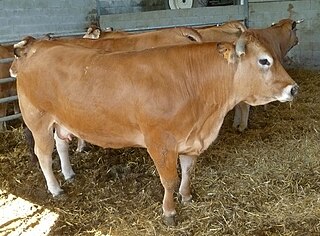
The Parthenaise is a French breed of beef cattle. It is named for the town of Parthenay in the département of Deux-Sèvres, in the Nouvelle-Aquitaine region of western France. It was formerly a triple-purpose breed, raised for milk, meat and draught work, but is now raised mainly for beef.
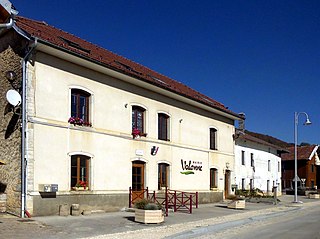
Valonne is a commune in the Doubs department in the Bourgogne-Franche-Comté region in eastern France.
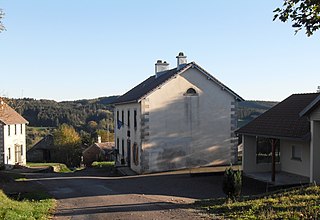
La Montagne is a commune in the Haute-Saône department in the region of Bourgogne-Franche-Comté in eastern France. It is part of the Vosges Massif with which it shares a common cultural and historical mountain ancestry.
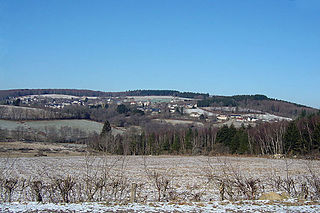
Montsauche-les-Settons is a commune in the Nièvre department in the region of Bourgogne-Franche-Comté in central France. Montsauche-les Settons is completely rural, the commune composed of a settlement, half of Lac des Settons (lake), and a few dispersed hamlets.

The Ferrandaise is an endangered French breed of domestic cattle from the département of Puy-de-Dôme, in the Massif Central mountains of Auvergne, in central France. It is named for the city and commune of Clermont-Ferrand, the capital of Puy-de-Dôme.
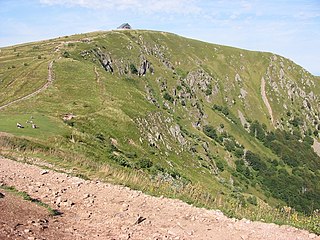
The Hohneck is, at 1,363 m (4,472 ft) the third highest summit of the Vosges Mountains and the highest point of Lorraine. On its summit stands a mountain hut, clearly visible in the distance. Nearby the mountain's top is located the ski resort of La Bresse Hohneck.

The Corse or Corsicana is a French breed of cattle indigenous to the island of Corsica.
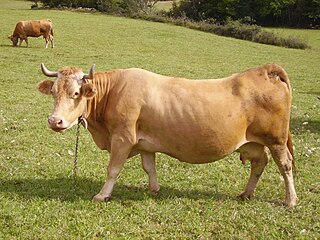
The Villard-de-Lans, or villarde, is a French cattle breed native to the outskirts of the homonymous town in the Vercors mountain pass within the French Prealps. This wheat-colored cow was for many years used for agricultural labor, milking and meat production, before World War II and the industrialization of cattle breeds led to its decline.

The Maraîchine is a French breed of beef cattle. It originates in, and is named for, the Marais Poitevin, the marshlands on the Atlantic coast of the département of the Vendée in western France.
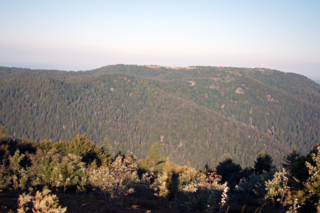
The Ballon de Servance is a summit in the Southern Vosges Mountains, located on the border of Bourgogne-Franche-Comté and the Grand Est region. It is the highest point in the Haute-Saône department and within the Comtois Balloons National Nature Reserve. It marks the first significant peak with an altitude exceeding 1,000 meters when approaching the Vosges Mountains from the southwest. Its neighbor, the Ballon d'Alsace, only surpasses it by 31 meters.

The history of French cattle breeding is the result of the intermingling of bovine populations from several European offshoots, after centuries of breeding and selection practices. The French herd includes crosses with zebus in the French overseas departments and territories.

The Marine Landaise is a French bovine breed with a very small population, benefiting from a conservation program and maintained in humid natural areas along the coast of the Landes de Gascogne, in the Landes and Gironde regions. Its vocation is environmental. It should not be confused with the Spanish fighting bull used courses landaises.

The mining basin of Ronchamp and Champagney is a territory located in the department of Haute-Saône and the French region of Bourgogne-Franche-Comté; economically, socially, environmentally, and culturally marked by the intensive exploitation of coal in its subsoil between the 18th and 20th centuries. It consists of the three main municipalities of Ronchamp, Champagney, and Magny-Danigon as well as several hamlets and other neighboring villages.